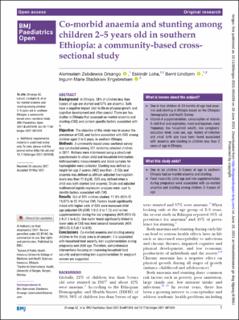Co-morbid anaemia and stunting among children 2–5 years old in southern Ethiopia: a community-based cross-sectional study
Journal article, Peer reviewed

Åpne
Permanent lenke
https://hdl.handle.net/11250/2760276Utgivelsesdato
2021-06-01Metadata
Vis full innførselSamlinger
- Publications [1488]
Originalversjon
in BMJ Paediatrics Open vol. 5 no. e001039 10.1136/bmjpo-2021-00103910.1136/bmjpo-2021-001039
10.1136/bmjpo-2021-001039
10.1136/bmjpo-2021-001039
Sammendrag
Background In Ethiopia, 38% of children less than 5 years of age are stunted and 57% are anaemic. Both have a negative impact later in life on physical growth and cognitive development and often coexist. There are few studies in Ethiopia that assessed co-morbid anaemia and stunting (CAS) and context-specific factors associated with it.
Objective The objective of this study was to assess the prevalence of CAS, and factors associated with CAS among children aged 2 to 5 years, in southern Ethiopia.
Methods A community-based cross-sectional survey was conducted among 331 randomly selected children in 2017. Mothers were interviewed using a structured questionnaire to obtain child and household information. Anthropometric measurements and blood samples for haemoglobin were collected. Stunting was defined as height-for-age Z-scores (HAZ) less than −2 SDs and anaemia was defined as altitude-adjusted haemoglobin levels less than 11.0 g/dL. CAS was defined when a child was both stunted and anaemic. Crude and adjusted multinomial logistic regression analyses were used to identify factors associated with CAS.
Results Out of 331 children studied, 17.8% (95% CI 13.87% to 22.4%) had CAS. Factors found significantly linked with higher odds of CAS were increased child age (adjusted OR (AOR) 1.0 (1.0 to 1.1)) and no iron supplementation during the last pregnancy (AOR (95% CI) 2.9 (1.3 to 6.2)). One factor found significantly linked to lower odds of CAS was food secured households (AOR (95% CI) 0.3 (0.1 to 0.9)).
Conclusions Co-morbid anaemia and stunting among children in the study area is of concern; it is associated with household food security, iron supplementation during pregnancy and child age. Therefore, comprehensive interventions focusing on improving household food security and promoting iron supplementation for pregnant women are suggested.
Serie
BMJ Paediatrics OpenBMJ Paediatrics Open
BMJ Paediatrics Open
BMJ Paediatrics Open